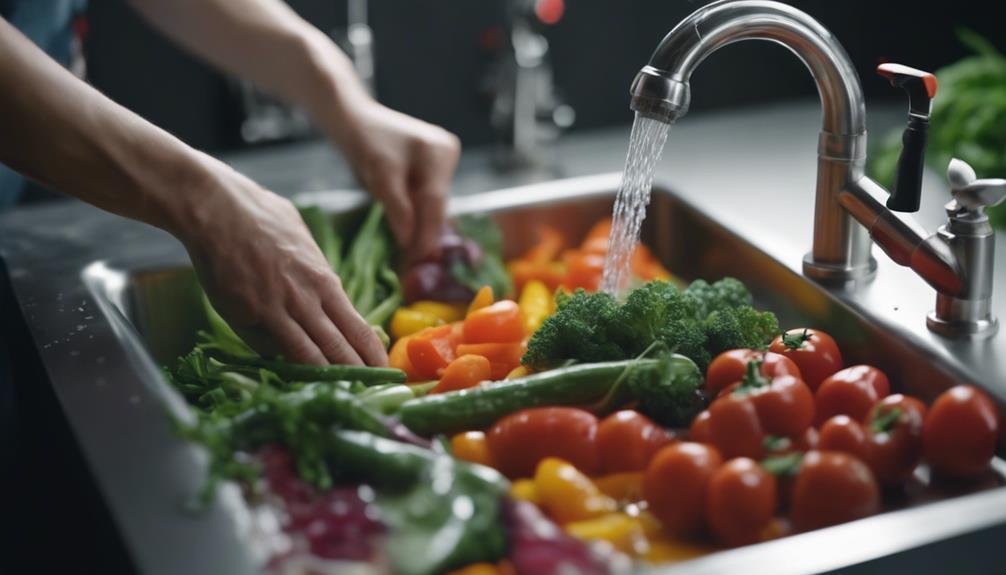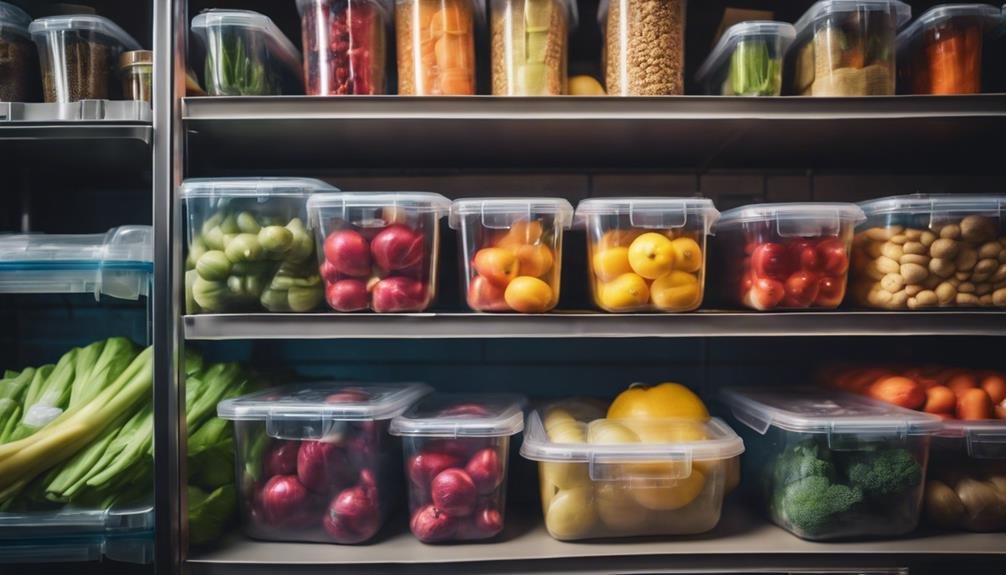Vacuum sealing is an effective way to minimize pesticide exposure in your home. By creating an airtight barrier, you'll shield food and household items from potential contamination. Start by thoroughly washing and drying produce before sealing. Use appropriate bags and follow manufacturer instructions for best results. This method not only protects against pesticides but also extends shelf life and preserves freshness. It's particularly useful for non-food items that might otherwise require chemical treatments. Keep in mind alternative pest control methods like IPM and natural solutions to further reduce pesticide reliance. By implementing these strategies, you'll create a safer, healthier environment for you and your family. Discover more ways to protect your home from harmful chemicals.
Understanding Pesticide Risks
There are three key things you'll need to understand about pesticide risks to protect yourself and your environment. First, pesticides aren't limited to just bug sprays; they include a wide range of products you might use daily, such as bleach and pool chemicals. This broad definition means you're likely exposed to more pesticides than you realize.
Second, improper use, storage, or disposal of pesticides can harm both you and the environment. It's important to treat these products with caution, even when using them for food preservation or other household tasks. Vacuum sealers, while excellent for extending food shelf life, don't eliminate pesticide residues on produce.
Third, reading and following product labels is crucial. These labels contain essential information about ingredients, warnings, safety equipment, and proper handling. By carefully adhering to these instructions, you'll greatly reduce your risk of exposure.
To minimize pesticide risks, consider non-chemical pest control methods first. When you do use pesticides, choose the right product for your needs, follow directions strictly, and store and dispose of them properly. Remember, prevention is key in reducing your overall pesticide exposure and protecting your health.
Vacuum Sealing Basics
Now that you're aware of pesticide risks, let's explore how vacuum sealing can help you minimize exposure to these potentially harmful substances. Vacuum sealing is an important method for creating an airtight barrier around your items, effectively protecting them from pesticide contamination.
By using vacuum sealing techniques, you're safeguarding your documents, clothing, and other valuable possessions from coming into contact with harmful chemicals. This process not only prevents cross-contamination but also helps maintain the quality and lifespan of your stored goods. Here's a quick overview of the benefits:
| Benefit | Description | Impact |
|---|---|---|
| Protection | Creates airtight barrier | Shields items from pesticides |
| Preservation | Maintains item quality | Extends lifespan of goods |
| Prevention | Avoids cross-contamination | Keeps items separate and safe |
Understanding the basics of vacuum sealing is essential for effectively minimizing pesticide exposure. By removing air and creating a sealed environment, you're ensuring that your items remain untouched by potentially harmful chemicals. This simple yet effective method can provide you with peace of mind, knowing that your belongings are protected from pesticide risks while in storage or during transportation.
Proper Produce Preparation

How can you guarantee your produce is ready for vacuum sealing to minimize pesticide exposure? It's important to properly prepare fruits and vegetables before sealing them away.
Start by thoroughly washing your produce to remove any pesticide residues and dirt. This step is vital for preserving food safely and reducing your exposure to harmful chemicals.
After washing, make sure you dry your fruits and vegetables completely. Any lingering moisture can lead to mold growth inside the plastic bag, compromising the quality of your vacuum-sealed produce.
Take the time to inspect your produce and remove any damaged or spoiled parts. This prevents contamination and helps maintain freshness.
For larger fruits or vegetables, consider cutting them into smaller pieces. This not only makes them easier to fit into vacuum sealing bags but also improves the sealing process.
When selecting containers for vacuum sealing, opt for appropriate bags or containers designed specifically for this purpose. These will help maintain the quality and freshness of your produce while effectively minimizing pesticide exposure.
Effective Sealing Techniques
Once you've properly prepared your produce, it's time to master effective sealing techniques to maximize pesticide protection and freshness.
Vacuum sealing is an excellent method to safeguard your items from potential pesticide exposure. By creating an airtight barrier, you'll prevent any residual pesticides from coming into contact with your stored goods.
To effectively vacuum seal, start by selecting appropriate bags for your items. Place the object inside the bag, ensuring there's enough space around it for a proper seal. Use your vacuum sealer according to the manufacturer's instructions, removing as much air as possible. This process creates a tight seal that protects against external contaminants, including pesticides.
When sealing food items, make sure they're completely dry to prevent moisture buildup. For non-food items like clothing or documents, consider using buffer materials to prevent crushing.
Storage and Shelf Life

Vacuum sealing doesn't just protect against pesticides; it'll dramatically extend the shelf life of your stored items. By creating a barrier against oxygen and moisture, vacuum sealing helps preserve the freshness and quality of your food for much longer periods.
This means you'll need to rely less on chemical preservatives and pesticides to keep your food edible.
When you vacuum seal your perishables, you're effectively minimizing the risk of pest infestations. Without air and moisture, many common food pests can't survive or reproduce, eliminating the need for pesticide use in storage areas.
This method of preservation also reduces the likelihood of contamination, further decreasing your reliance on chemical interventions.
Health Benefits and Considerations
Beyond its preservative powers, vacuum sealing offers significant health benefits by reducing your exposure to harmful pesticides and chemicals. By utilizing this method, you can create a protective barrier between your food and potential contaminants, ensuring a healthier diet for you and your family.
When you vacuum seal fresh produce and groceries, you're not only extending their shelf life but also minimizing the need for additional pesticides. This practice promotes healthier eating habits and reduces your overall pesticide exposure.
For non-perishable items like grains and legumes, vacuum sealing provides an extra layer of protection against pesticides commonly used in storage facilities.
You can also apply vacuum sealing to emergency kits, reducing your reliance on pesticide-containing products for pest control during disasters. By implementing this technique for long-term food storage, you'll limit your exposure to pesticides found in commercially packaged goods.
Incorporating vacuum sealing into your food storage routine is a proactive step towards a healthier lifestyle. It's an effective way to take control of your food quality and minimize pesticide exposure, ultimately contributing to your overall well-being.
Equipment and Supplies

You'll need a few key pieces of equipment and supplies to effectively vacuum seal and minimize pesticide exposure. First and foremost, you'll require a vacuum sealer, which is the primary tool for this process. Choose a model that's reliable and easy to use, as you'll be handling potentially hazardous materials.
Next, you'll need vacuum sealing bags that are sturdy enough to contain pesticide containers safely. Look for bags that are thick and puncture-resistant to prevent leaks or spills. It's also helpful to have bags in various sizes to accommodate different container shapes and sizes.
Don't forget to include protective gear in your equipment list. Gloves, goggles, and a mask are essential for handling pesticides safely. You can even vacuum seal these items separately to keep them clean and ready for use.
Consider investing in storage containers or bins to organize your vacuum-sealed pesticide containers. This will help you categorize different types of pesticides and make them easier to locate when needed. By having the right equipment and supplies on hand, you'll be well-prepared to minimize pesticide exposure through effective vacuum sealing.
Alternative Pesticide Reduction Methods
While vacuum sealing is an effective method for minimizing pesticide exposure, there are several other techniques you can employ to reduce your reliance on chemical pest control.
By implementing alternative pesticide reduction methods, you'll not only protect yourself and your family but also contribute to a healthier environment.
One approach is to focus on physical pest control methods. Hand weeding, trapping, and using beneficial insects can be just as effective as chemical pesticides in many cases. You can also utilize native plants in your garden to attract helpful insects that naturally control pests.
Integrated Pest Management (IPM) is another strategy worth considering. This approach combines various pest control methods to minimize pesticide use. When dealing with indoor pests like fleas, regular vacuuming and washing of pet bedding can be highly effective.
To further reduce your reliance on pesticides, consider these four steps:
- Use mechanical traps and flyswatters for indoor pest control
- Implement IPM strategies in your garden and home
- Vacuum seal non-food items to protect them from pests
- Educate yourself on natural pest control methods
Conclusion
You've now discovered the secret to minimizing pesticide exposure through vacuum sealing. With these techniques, you'll be eating produce so clean it could make a germaphobe jealous!
Remember to properly prepare your fruits and veggies, seal them effectively, and store them correctly. While vacuum sealing isn't the only method, it's a powerful tool in your health arsenal.
Keep exploring alternative ways to reduce pesticides and enjoy safer, healthier meals for you and your family.
